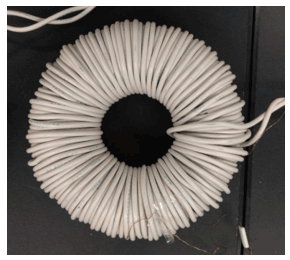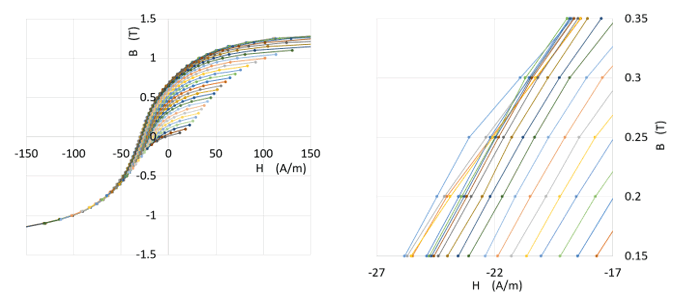Contents
1. Introduction
2. Measurement
3. Relationship between symmetric BH loops and minor loop in Play model
4. Numerical experiments
5. Summary
6. References
1. Introduction
Accurate prediction of losses is a critical subject in machine design for advanced applications such as an electric vehicle (EV) since it provides important information for loss reduction and better cooling configuration. Although loss prediction techniques have been improved, estimating hysteresis loss of the lamination steel is still challenging. Conventional methods are based on Steinmetz’s empirical equation, which does not have the ability to reproduce minor loops. The loss that comes from minor loops is non-negligeable in the advanced machine designs and an alternative method is required.
The Play model is a magnetization model to reproduce arbitrary minor loops. The advantage of the Play model is that it does not require BH (magnetic flux density B and magnetic field H) information at the actual operating conditions, which are sometimes difficult to generate in material measurements, but requires only symmetric BH loops measured in the static condition. Furthermore, the model can be used in eddy current calculation with the electromagnetic finite element analysis (FEA) to reproduce minor loops in dynamic fields with the static BH loops. Therefore, the Play model is often used for accurate loss calculations thanks to the desirable representation ability.
A remaining issue of the Play model is the preparation of the BH loops. The reason is the following. The resolution of the minor loop representation is determined by the resolution of the BH loops, which is the number of BH loops in a range of magnetic density. As the number of BH loops increases, the interval between BH loops decreases. Therefore, the error of the measurements has to be small enough compared to the interval and the preparation of the BH loops becomes difficult as the requirement for the accuracy of a minor loop becomes high. Since there is a limit to measurement quality in practice and it is impossible to obtain the ideal BH loops, a certain level of fluctuations caused by measurements of the BH loops needs to be accepted. Therefore, it is important to understand the influence of fluctuations on the accuracy of the minor loops.
In this paper, we clarify the influence mechanism from fluctuations of the symmetric BH loops to a resulting minor loop and estimate errors caused by the fluctuations. The detail of measurement is described in the next section. Section III describes the relationship between the BH loops and a minor loop for typical operating conditions. The errors are estimated based on the relationship and numerically validated in Section 4 followed by conclusions in Section 5.
2. Measurement
Two kinds of measurement are conducted. The firsts are the symmetric BH loops that will be the input for the Play model. Symmetric BH loops are measured with flux density amplitudes from 0.05 T to 1.65 T with 0.05 T increments. The seconds are the measurements of minor loop hysteresis loss under DC superposition. The DC bias Bdc ranges from 0.2 T to 1.4 T, with the amplitude of the minor loop fixed to 0.2 T. All measurements are performed in quasi-direct current conditions (0.05 Hz) to avoid introducing eddy current effects.
The ring core used for the measurements is made of 20 35A210 sheets with an inner diameter of 100 mm and an outer diameter of 120 mm. The steel sheets are inserted into a case to prevent any effect from stresses due to the winding of coils around the core. The strength of the magnetic field is measured using the excitation current method.
Fig.1 shows a photograph of the sample. The excitation coil has 405 turns and the coil measuring the magnetic flux density has 210 turns.
 Fig. 1 Ring specimen of 35A210
Fig. 1 Ring specimen of 35A210
3. Relationship between symmetric BH loops and minor loop in Play model
Crossing of symmetric BH loops is a typical symptom of measurement error. In particular, the loops intersect where the magnetic field H between the symmetrical loops is closely spaced. Fig.2 shows the measured BH loops of 35A210 steel. The left is descending curves, and the right is the enlarged view. Loops with high flux density amplitude intersect.
 Fig. 2 Symmetric BH loop (Left : Descending curve, Right : Enlarged view with crossover)
Fig. 2 Symmetric BH loop (Left : Descending curve, Right : Enlarged view with crossover)
You need to sign in as a Regular JMAG Software User (paid user) or JMAG WEB MEMBER (free membership).
By registering as a JMAG WEB MEMBER, you can browse technical materials and other member-only contents for free.
If you are not registered, click the “Create an Account” button.
Create an Account Sign in



